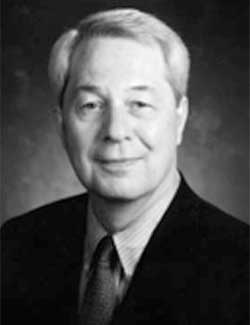2001 Karl Meyer Award Winner
At Duke, Hill continued his work on human hemoglobins, but soon turned his attention to the structure-function relationships of other proteins and enzymes, including human fibrinogen and other blood coagulation factors, immunoglobulins, egg-white lysozyme, bacterial acyl carrier protein, and lactose synthase (1). He and his colleagues proposed the domain structure of the light and heavy chains of immunoglobulins based on their partial amino acid sequences and also proposed the evolutionary origins of the different types of immunoglobulin chains. In addition, Hill established the complete amino acid sequence of bovine α-lactalbumin and described its evolutionary origins from lysozyme. In subsequent years he studied many other glycosyltransferases and worked in several areas of glycobiology. In 1969, Hill became the chairman of the Department of Biochemistry at Duke and in 1974 the James B. Duke Professor. He served as chairman until 1993. He was president (1976) and secretary (1972-1975) of the American Society of Biological Chemists. He was also on the editorial board (1965-1970; 1972-1977) and an associate editor (1988-present) of the Journal of Biological Chemistry. He received the William C. Rose Award from the Society in 1991.He served on the board of the Federation of American Societies for Experimental Biology (1972-1978), was general secretary of the International Union of Biochemistry (1982-1991), and chair of the Organizing Committee of the 17th International Congress of Biochemistry and Molecular Biology in San Francisco, California in 1997. He was elected to the National Academy of Sciences in 1975, to the Institute of Medicine in 1978, and to the American Academy of Arts and Sciences in 1974. |

 Robert L. Hill was born in Kansas City, Missouri. He earned a B.A. in chemistry (1949) and a Ph.D. in biochemistry (1954) from the University of Kansas and was a postdoctoral fellow (1954-1956) with Emil L. Smith at the University of Utah. At Utah, he published papers on proteolytic enzymes and human hemoglobin and myoglobin. He remained there as a faculty member of the Department of Biochemistry until 1961. He then joined the Department of Biochemistry at Duke University School of Medicine, where he remains today.
Robert L. Hill was born in Kansas City, Missouri. He earned a B.A. in chemistry (1949) and a Ph.D. in biochemistry (1954) from the University of Kansas and was a postdoctoral fellow (1954-1956) with Emil L. Smith at the University of Utah. At Utah, he published papers on proteolytic enzymes and human hemoglobin and myoglobin. He remained there as a faculty member of the Department of Biochemistry until 1961. He then joined the Department of Biochemistry at Duke University School of Medicine, where he remains today.